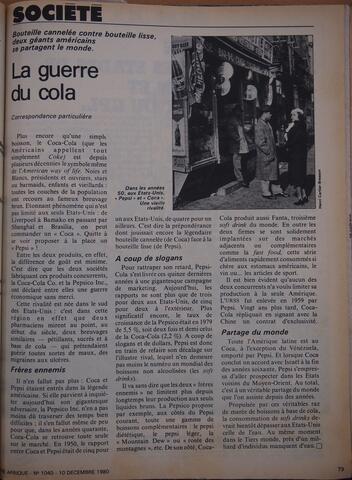Alternative Title
Jeune Afrique
Identifier
P7192633.jpg
Member of
Date Created
1980-12-10
Language
Resource Type
Genre
Extent
Volume Number: 1040
Note
Fluted bottle versus smooth bottle, two American giants share the world. [Bigger text] The Cola Wars [Smaller text] Special correspondence. More than just a drink, Coca-Cola (which Americans simply call Coke) has for decades been the very symbol of the American way of life. Blacks and whites, presidents and workers, celebrities and bartenders, children and the elderly: all sections of the population use the famous brown beverage. It's an amazing phenomenon that is not limited to the United States alone: from Liverpool to Bamako, via Shanghai and Brasilia, you can order a "Coca-Cola". Even if you are offered a "Pepsi!" instead. The difference in taste between the two products is minimal. This means that the two companies that produce these competing products, the Coca-Cola Co. and Pepsico Inc. have declared a merciless economic war between them. The rivalry originated in the southern United States, where two pharmacists developed two similar drinks - sparkling, sweet and cola-based - at the turn of the century that claimed to cure everything from migraines to ulcers. Brothers and enemies: It didn't take much more than that: Coca and Pepsi had become part of American legend. Although Pepsico Inc. has managed to worry its gigantic adversary today, it has nevertheless had to go through some very difficult times; it was even close enough for Coca-Cola to find itself on the market on its own in the 1940s. In 1950, the ratio of Coca-Cola to Pepsi was five to one in the United States and four to one elsewhere. This shows the preponderance that the legendary fluted bottle (of Coca) still enjoyed over the smooth bottle (of Pepsi). Slogans: To make up for lost time, Pepsi-Cola has launched a massive marketing campaign over the past 15 years. Today, the ratio is only three to two in the United States and five to two outside the country. Even more significantly, Pepsico's growth rate in 1979 was 5.5%, two and a half times that of Coca-Cola (2.2%). With slogans and dollars, Pepsi is therefore falling behind its illustrious rival, which is nonetheless the world's number one soft drink rival. It goes without saying that the two "enemy brothers" have long since stopped limiting their production to brown drinks alone. Pepsico, for example, offers a whole range of complementary drinks alongside the common Pepsi: diet pepsi, light pepsi, "Mountain Dew", etc. Coca-Cola also produces Fanta, the world's third largest soft drink. In addition, the two companies have established a solid foothold in adjacent or complementary markets such as fast food, that series of fast-moving foods so dear to American stomachs, wine or... sporting goods. It is quite obvious that neither competitor wanted to limit its production to America alone. The USSR was taken over by Pepsi in 1959. Twenty years later, Coca-Cola replied by signing an exclusive contract with China. Share the world: All of Latin America is Coca-Cola's, except Venezuela, which was taken over by Pepsi. And when Coca-Cola reached an agreement with Israel at the end of the 1960s, Pepsi was quick to go prospecting in neighbouring Middle Eastern states. All in all, the world has been divided for years. Propelled by these veritable tidal waves of cola-based drinks, the consumption of soft drinks in the United States should soon surpass that of water. At the same time in the Third World, nearly a billion people are short of water. [Photo caption] In the 1950s, in the United States, "Pepsi" and "Coca". An old rivalry.
Abstract
The article takes up most of the page. In one corner is a photo depicting a street with lots of signs advertising different types of cola.
Continent
Country
Language Code
Internal Note
Emma Chilton


